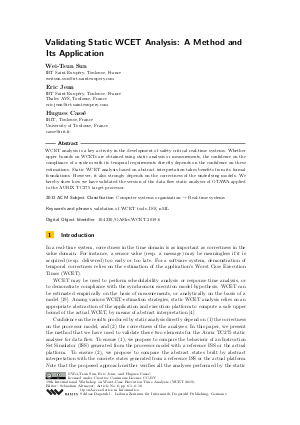Validating Static WCET Analysis: A Method and Its Application
Authors Wei-Tsun Sun, Eric Jenn, Hugues Cassé
-
Part of:
Volume:
19th International Workshop on Worst-Case Execution Time Analysis (WCET 2019)
Part of: Series: Open Access Series in Informatics (OASIcs)
Part of: Conference: Workshop on Worst-Case Execution Time Analysis (WCET) - License:
 Creative Commons Attribution 3.0 Unported license
Creative Commons Attribution 3.0 Unported license
- Publication Date: 2019-07-03
File

PDF
OASIcs.WCET.2019.6.pdf
- Filesize: 0.62 MB
- 10 pages
Document Identifiers
Subject Classification
ACM Subject Classification
- Computer systems organization → Real-time systems
Keywords
- validation of WCET tools
- ISS
- nML
Metrics
- Access Statistics
-
Total Accesses (updated on a weekly basis)
0PDF Downloads0Metadata Views
Abstract
WCET analysis is a key activity in the development of safety critical real-time systems. Whether upper bounds on WCETs are obtained using static analysis or measurements, the confidence on the compliance of a system with its temporal requirements directly depends on the confidence on these estimations. Static WCET analysis based on abstract interpretation takes benefits from its formal foundations. However, it also strongly depends on the correctness of the underlying models. We hereby show how we have validated the version of the data flow static analyser of OTAWA applied to the AURIX TC275 target processor.
Cite As Get BibTex
Wei-Tsun Sun, Eric Jenn, and Hugues Cassé. Validating Static WCET Analysis: A Method and Its Application. In 19th International Workshop on Worst-Case Execution Time Analysis (WCET 2019). Open Access Series in Informatics (OASIcs), Volume 72, pp. 6:1-6:10, Schloss Dagstuhl – Leibniz-Zentrum für Informatik (2019)
https://doi.org/10.4230/OASIcs.WCET.2019.6
BibTex
@InProceedings{sun_et_al:OASIcs.WCET.2019.6,
author = {Sun, Wei-Tsun and Jenn, Eric and Cass\'{e}, Hugues},
title = {{Validating Static WCET Analysis: A Method and Its Application}},
booktitle = {19th International Workshop on Worst-Case Execution Time Analysis (WCET 2019)},
pages = {6:1--6:10},
series = {Open Access Series in Informatics (OASIcs)},
ISBN = {978-3-95977-118-4},
ISSN = {2190-6807},
year = {2019},
volume = {72},
editor = {Altmeyer, Sebastian},
publisher = {Schloss Dagstuhl -- Leibniz-Zentrum f{\"u}r Informatik},
address = {Dagstuhl, Germany},
URL = {https://drops.dagstuhl.de/entities/document/10.4230/OASIcs.WCET.2019.6},
URN = {urn:nbn:de:0030-drops-107713},
doi = {10.4230/OASIcs.WCET.2019.6},
annote = {Keywords: validation of WCET tools, ISS, nML}
}
Author Details
References
-
AURIX TC27x D-Step 32-Bit Single-Chip Microcontroller User’s Manual V2.2 2014-12.

-
Hugues Cassé, Florian Birée, and Pascal Sainrat. Multi-architecture value analysis for machine code. In 13th International Workshop on Worst-Case Execution Time Analysis, pages pp-42, 2013.

-
Hugues Cassé and Pascal Sainrat. OTAWA, a framework for experimenting WCET computations. In 3rd European Congress on Embedded Real-Time Software, volume 1, 2006.

-
Patrick Cousot and Radhia Cousot. Abstract interpretation: a unified lattice model for static analysis of programs by construction or approximation of fixpoints. In Proceedings of the 4th ACM symposium on Principles of programming languages, pages 238-252, 1977.

-
Thanh Nga Dang, Abhik Roychoudhury, Tulika Mitra, and Prabhat Mishra. Generating test programs to cover pipeline interactions. In 2009 46th ACM/IEEE Design Automation Conference, pages 142-147. IEEE, 2009.

-
Christian Ferdinand and Reinhold Heckmann. ait: Worst-case execution time prediction by static program analysis. In Building the Information Society, pages 377-383. Springer, 2004.

-
Christian Ferdinand, Reinhold Heckmann, Marc Langenbach, Florian Martin, Michael Schmidt, Henrik Theiling, Stephan Thesing, and Reinhard Wilhelm. Reliable and precise WCET determination for a real-life processor. In International Workshop on Embedded Software, page 469–485. Springer, 2001.

-
Jan Gustafsson, Adam Betts, Andreas Ermedahl, and Björn Lisper. The Mälardalen WCET benchmarks: Past, present and future. In 10th International Workshop on Worst-Case Execution Time Analysis. Schloss Dagstuhl-Leibniz-Zentrum fuer Informatik, 2010.

-
Jan Gustafsson, Andreas Ermedahl, Björn Lisper, Christer Sandberg, and Linus Källberg. ALF-a language for WCET flow analysis. In 9th International Workshop on Worst-Case Execution Time Analysis (WCET'09). Schloss Dagstuhl-Leibniz-Zentrum für Informatik, 2009.

-
Xavier Leroy et al. The CompCert verified compiler. Documentation and user’s manual. INRIA Paris-Rocquencourt, 53, 2012.

-
André Maroneze, Sandrine Blazy, David Pichardie, and Isabelle Puaut. A formally verified WCET estimation tool. In 14th International Workshop on Worst-Case Execution Time Analysis. Schloss Dagstuhl-Leibniz-Zentrum fuer Informatik, 2014.

-
Fadia Nemer, Hugues Cassé, Pascal Sainrat, Jean-Paul Bahsoun, and Marianne De Michiel. Papabench: a free real-time benchmark. In 6th International Workshop on Worst-Case Execution Time Analysis (WCET'06). Schloss Dagstuhl-Leibniz-Zentrum für Informatik, 2006.

-
Tahiry Ratsiambahotra, Hugues Cassé, and Pascal Sainrat. A versatile generator of instruction set simulators and disassemblers. In 2009 International Symposium on Performance Evaluation of Computer &Telecommunication Systems, volume 41, pages 65-72. IEEE, 2009.

-
Marc Schlickling and Markus Pister. Semi-automatic derivation of timing models for WCET analysis. In ACM Sigplan Notices, volume 45, 4, pages 67-76. ACM, 2010.

-
Rathijit Sen and YN Srikant. Executable analysis with circular linear progressions. Technical report, Technical Report IISc-CSA-TR-2007-3, Computer Science and Automation Indian …, 2007.

-
Wei-Tsun Sun and Hugues Cassé. Dynamic branch resolution based on combined static analyses. In 16th International Workshop on Worst-Case Execution Time Analysis-WCET 2016. OASICs, Dagstuhl Publishing, 2016.

-
TriCore™ TriCore™ V1.6 Microcontrollers User Manual (Volume 2).

-
Johan Van Praet, Dirk Lanneer, Werner Geurts, and Gert Goossens. nML: A structural processor modeling language for retargetable compilation and ASIP design. In Processor Description Languages, pages 65-93. Elsevier, 2008.

-
Reinhard Wilhelm, Jakob Engblom, Andreas Ermedahl, Niklas Holsti, Stephan Thesing, David Whalley, Guillem Bernat, Christian Ferdinand, Reinhold Heckmann, Tulika Mitra, et al. The worst-case execution-time problem—overview of methods and survey of tools. ACM Transactions on Embedded Computing Systems (TECS), 7(3):36, 2008.

